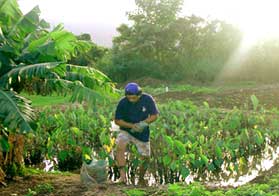|
Taro,
the Hawaiian soul food, is grown throughout Hawai`i in two
ways--on dry land or in shallow, watery terraces and patches
called lo`i that Stilts and other native Hawaiian birds
frequent. Taro begins life as a corm, or underground stem.
The parent corm produces glossy green heart-shaped leaves
and anywhere from two to 15 suckers, or shoots called oha.
The
oha is one method by which taro propagates or reproduces.
The Hawaiian word for family isohana, which means
many shoots. Taro is deeply entwined with family and just
as intimately linked with Hawaiian language, mythology,
land, society and even table manners.
Taro Hawaiians
call it kalo is the number one staple of the Hawaiian
diet and loaded with nutrients. Don't miss out on a
buying a bag of crunchy deep fried taro chips at the local
market. Try it in biscuits, bread, muffins or pancakes.
Cook the leaves and eat them like spinach. Get taro baked,
boiled, steamed or mashed into paste-like poi;but you
might have to wait in line for the latter, because local
people know when bags of fresh purple poi arrive in the
store and everyone has a favorite brand. For some, poi is
an acquired taste; for others, i's a way of life,
with many known and proven health benefits.
Taro lovers harvest and peel the corms the underground
tuber ;then cook them and eat them like potatoes. They
mash the well cooked corm with water to make poi. Taro is
an excellent source of carbohydrates, and because it is
an alkali-producing food, it helps to balance the pH factor
in the body. Taro leaves, called lu`au—they give the
Hawaiian feast its name--taste similar to spinach and are
rich in calcium, iron, phosphorus, thiamine, riboflavin
and vitamins A, B and C.
In
the last decade, a study engaging native Hawaiians on a
heritage diet featured taro as a key menu item. Participants
experienced significant weight loss and improved health,
with much of the credit for the results going to taro.
Easily
digestible, taro is the perfect food for babies and the
elderly. A manufacturer of powdered taro ships it internationally
to hospitals seeking supplements for babies with food allergies.
One
of about 30 or so species of plants that ancient Polynesians
brought with them to these islands in their voyaging canoes,
the precious taro is deeply entwined in the culture. An
ancient Hawaiian chant, the Kumulipo, details the creation
of the universe. It tells of Wakea, the sky god, forming
a union with his daughter. Together, they had two sons.
The first son, Haloa-naka it means long, trembling
stem--was born malformed, apparently lifeless. Buried outside
the home, Haloa-naka grew to become the taro plant. The
second born son was perfectly formed. Wakea named him Haloa,
which means long stem. Haloa became the first man and the
ancestor of all Hawaiian people.
To this day, Hawaiians love, respect and malama, or care
for, the taro plant, revering it as an elder brother. Hawaiian
people malama the taro plant, and in return, the taro will
malama us back by providing food.
Protocol
is extremely important in Hawaiian society. In ancient times--and
in some families today--when dining together around a poi
bowl, family members take turns dipping one or two fingers
into the poi bowl to scoop up poi, sustaining themselves
through their older brother. Hawaiian culture teaches respect
for the kupuna, or family elders, and because Haloa-naka
is present in the open poi bowl, traditionally there is
no displaying of anger or quarreling during mealtime. A
cover for the poi bowl stands nearby in the event there
might be an unintentional breach of protocol.
To
experience and appreciate taro in its many forms, and honor
the `ohana of taro farmers and other people who malama `aina,
or take care of the land, check out taro festivals held
at various times throughout the islands. Just remember,
no fighting over the open poi bowl!!
To
learn more about food and culture and other things unique
to Hawaii, click on Hawaii Health Guide's "Hawaiian
Experience " Heading and and explore the categories
and listings found there, contact the following organizations
and visit the following locations:
Big
Island
Amy B.H. Greenwell Ethnobotanical Garden
65 varieties of dryland taro
Captain Cook, Big Island
www.bishopmuseum.org/greenwell
808 323-3318
Hui Kalo Moku O Keawe (contact for many small gardens)
Hilo, Big Island (808) 965-8394
Waipi`o
Valley
Arrange tours with private companies
Kaua`i
CTAHR Kauai Agricultural Research Center
Kapa`a, Kauai (808) 822-4984
Hanalei National Wildlife Refuge Complex Overlook
Beyond Princeville on way to Hanalei
Overlooks acres of taro
Limahuli Garden
Walk through acres of historic taro terraces
http://ntbg.org/tours.html
808 826-1053
Waipa
Poi-making on Thursday mornings
808 639-1815
Maui
Ke`anae Arboretum
Halfway to Hana
.8 mile past mile marker 16
Ke`anae
Tropical Garden
Ke`anae, Maui (808) 248-7605
Ke`anae
Village
Historic site with taro
Ke`anae
Peninsula Overlook
Mile marker 17
Overlooks acres of taro
Kahanu Garden, Hana
Dryland taro
http://ntbg.org/tours.html
(808) 248-8912
CTAHR
Maui Agricultural Research Center
Kula, Maui (808) 878-1213
Oahu
Beatrice H. Krauss Hawaiian Ethnobotanical Garden
Lyon Arboretum
Honolulu, Manoa Valley
http://www.hawaii.edu/lyonarboretum/
808 988-0456
Kanewai Cultural Garden
University of Hawaii, Manoa
Honolulu, Manoa Valley
(808) 956-6825
Take
a virtual tour of taro terraces
Located on O`ahu in the ahupua`a of Kahana
http://geocities.com/ahupuaa/Pages/ahupuaa/kahana.html
|


















